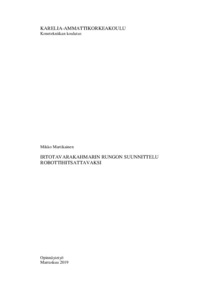Irtotavarakahmarin rungon suunnittelu robottihitsattavaksi
Martikainen, Mikko (2019)
Martikainen, Mikko
2019
All rights reserved. This publication is copyrighted. You may download, display and print it for Your own personal use. Commercial use is prohibited.
Julkaisun pysyvä osoite on
https://urn.fi/URN:NBN:fi:amk-2019120424476
https://urn.fi/URN:NBN:fi:amk-2019120424476
Tiivistelmä
Tämän opinnäytetyön aiheena oli tutkia käsin hitsatun satamanosturin kahmarin rungon robotisointia ja valmistettavuutta hitsauksen osalta. Työn tavoitteena oli kehittää havaittuihin ongelmiin ratkaisut ja lopuksi verrata kehitetyn version valmistuskustannuksia alkuperäiseen.
Ennen työn varsinaista toteutusta raportin alussa olevaa teoriaosuutta varten koostettiin tietoa valmistusystävällisyyden perusteista hitsatuissa rakenteissa. Tietoa hankittiin alan kirjallisuuden ja yritysvierailujen avulla. Työn käytännön osuudessa on selvitetty alkuperäisen rungon ongelmia robotisoinnin kannalta ja raportoitu niihin liittyvistä ratkaisuvaihtoehdoista. Luonnosten pohjalta uudesta rungosta piirrettiin valmistuskuvat kustannusten selvittämiseksi.
Työssä onnistuttiin vähentämään nimikkeiden, osien ja levynvahvuuksien määrää. Rakennemuutosten avulla onnistuttiin poistamaan sisäpuolisia hitsejä ja yhtenäistämään hitsien muotoja ja tyyppejä. Rungosta tunnistettiin myös robotisoinnin kannalta yleisesti ongelmallisia kohtia ja niihin löydettiin erilaisia ratkaisuvaihtoehtoja. This thesis examined the robotization and manufacturability of the clamshell bucket frame of a hand-welded quay crane in terms of welding. The goal was to develop solutions to the perceived problems and then compare the manufacturing costs between the developed version and the original.
Prior to starting the actual thesis, information regarding the basics of production-friendliness in welded structures was compiled to the theoretical section at the beginning of the report. The information was gathered through industrial visits and literature related to the field. The practical section of the thesis determined the problems of robotization in the original frame and reported options to solve them. Manufacturing illustrations of the new frame were drawn based on drafts to determine the expenses.
The thesis succeeded in reducing the number of headings and components as well as plate thickness. The structural changes helped to remove internal welds and unify different forms and types of welding. Furthermore, commonly problematic parts for robotization were identified in the frame, and different options to solve them were found.
Ennen työn varsinaista toteutusta raportin alussa olevaa teoriaosuutta varten koostettiin tietoa valmistusystävällisyyden perusteista hitsatuissa rakenteissa. Tietoa hankittiin alan kirjallisuuden ja yritysvierailujen avulla. Työn käytännön osuudessa on selvitetty alkuperäisen rungon ongelmia robotisoinnin kannalta ja raportoitu niihin liittyvistä ratkaisuvaihtoehdoista. Luonnosten pohjalta uudesta rungosta piirrettiin valmistuskuvat kustannusten selvittämiseksi.
Työssä onnistuttiin vähentämään nimikkeiden, osien ja levynvahvuuksien määrää. Rakennemuutosten avulla onnistuttiin poistamaan sisäpuolisia hitsejä ja yhtenäistämään hitsien muotoja ja tyyppejä. Rungosta tunnistettiin myös robotisoinnin kannalta yleisesti ongelmallisia kohtia ja niihin löydettiin erilaisia ratkaisuvaihtoehtoja.
Prior to starting the actual thesis, information regarding the basics of production-friendliness in welded structures was compiled to the theoretical section at the beginning of the report. The information was gathered through industrial visits and literature related to the field. The practical section of the thesis determined the problems of robotization in the original frame and reported options to solve them. Manufacturing illustrations of the new frame were drawn based on drafts to determine the expenses.
The thesis succeeded in reducing the number of headings and components as well as plate thickness. The structural changes helped to remove internal welds and unify different forms and types of welding. Furthermore, commonly problematic parts for robotization were identified in the frame, and different options to solve them were found.
